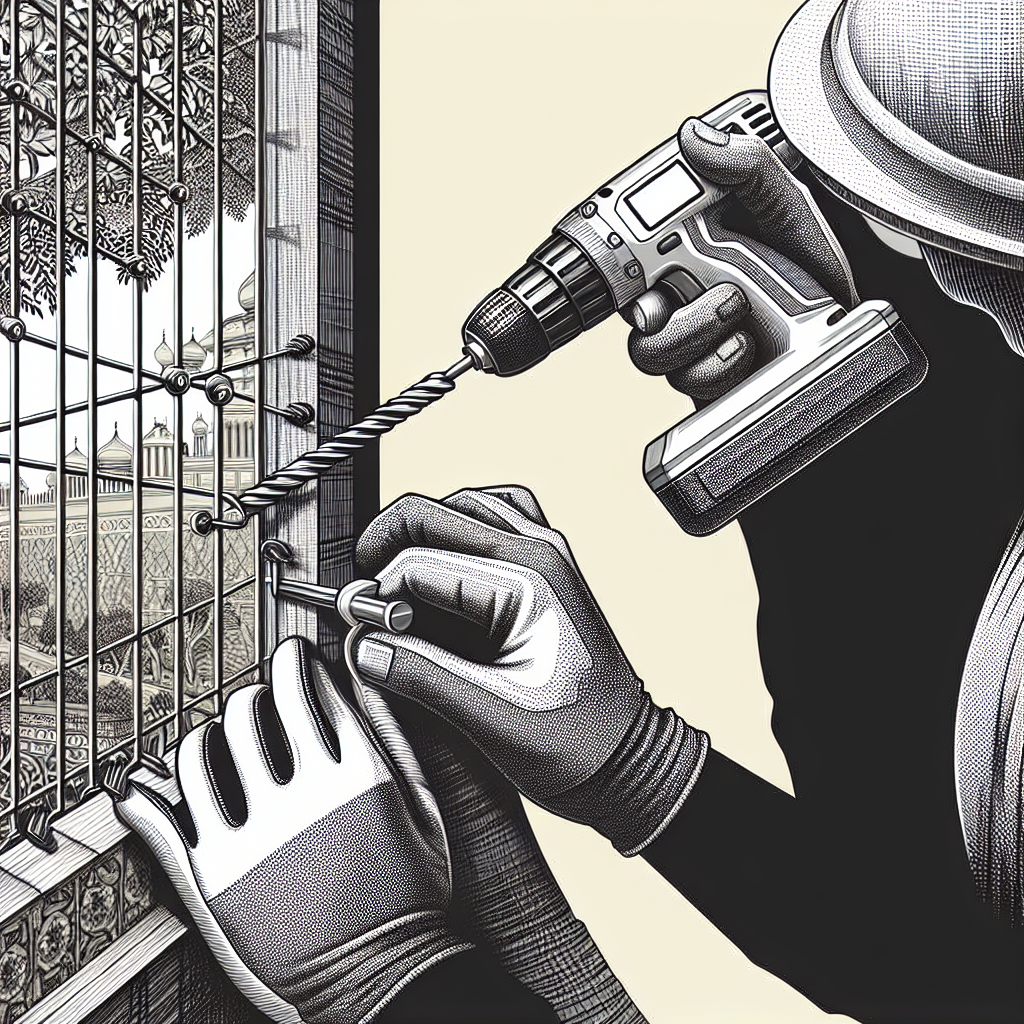In this article, you will discover a simple and effective method to attach a privacy screen to your fence. If you’ve been looking for a way to add some privacy to your outdoor space without compromising on style, this is the perfect solution for you. With our step-by-step guide, you’ll learn the best techniques to secure a privacy screen to your existing fence, ensuring a comfortable and secluded environment in no time. So, let’s dive into the easy steps that will transform your outdoor space into a private oasis!
Tools and Materials Needed
To attach a privacy screen to your fence, you will need the following tools and materials:
Measuring Tape
A measuring tape is essential for taking accurate measurements of your fence and privacy screen.
Privacy Screen
Choose a privacy screen that suits your needs and preferences. Privacy screens are available in various materials, such as wood, vinyl, or metal.
Zip Ties
Zip ties are used to securely fasten the privacy screen to the fence. Make sure to choose high-quality zip ties that can withstand outdoor conditions.
Drill
A drill is necessary for creating holes in the privacy screen and fence for attaching screws or zip ties.
Screws
If you choose to attach the privacy screen with screws, you will need the appropriate screws for your fence material.
Hinges
If you want to create a hinged privacy screen, hinges will be required to attach the screen to the fence.
Lattice Panels
Lattice panels can be used as an alternative privacy screen. If you choose this option, you will need lattice panels and the necessary hardware for installation.
Level
A level will help you ensure that the privacy screen is straight and properly aligned.
Wood Clamps
Wood clamps may be needed when working with lattice panels or for securing the privacy screen during installation.
Screwdriver
A screwdriver is necessary for tightening screws and attaching the privacy screen to the fence.
Preparing the Fence
Before attaching a privacy screen to your fence, it is essential to properly prepare the fence. Follow these steps for a successful installation:
Inspecting the Fence
Thoroughly inspect the fence for any damages or issues. Check for loose boards, broken pieces, or signs of rot. It is crucial to address these problems before attaching the privacy screen.
Cleaning the Fence
Clean the fence to remove any dirt, debris, or contaminants that may affect the adhesion or attachment of the privacy screen. You can use a hose, scrub brush, and mild detergent to clean the fence surface.
Repairing Any Damages
If you discovered any damages during the inspection, make the necessary repairs before attaching the privacy screen. Replace broken boards, reinforce weak sections, or fix any structural issues to ensure a stable foundation for the screen.
Determining the Fence Height
Measure the height of your existing fence to determine the height of the privacy screen you will need. Consider the desired level of privacy and select a screen height accordingly.
Marking the Placement of Privacy Screen
Using a pencil or chalk, mark the desired placement of the privacy screen on the fence. Take into account any gates or openings in the fence that may require special considerations when positioning the screen.

Choosing the Privacy Screen
When selecting a privacy screen, consider the following factors to make the right choice for your needs:
Selecting the Material
Privacy screens are available in various materials, such as wood, vinyl, or metal. Each material has its own advantages and disadvantages in terms of durability, maintenance, and aesthetic appeal. Choose the material that best suits your preferences and matches your existing fence.
Determining the Desired Privacy Level
Consider the level of privacy you want to achieve with the screen. Some screens provide complete privacy, while others offer partial visibility. Evaluate your needs and select a screen that provides the desired level of privacy.
Checking the Screen Quality
Inspect the quality of the privacy screen before purchase. Look for sturdy construction, proper finishing, and materials that can withstand outdoor conditions. Consider customer reviews and recommendations to ensure you choose a reliable and durable privacy screen.
Measuring and Cutting the Privacy Screen
Accurate measurements and proper cutting are crucial for a seamless attachment of the privacy screen. Follow these steps to measure and cut the screen accurately:
Measuring the Fence
Using a measuring tape, measure the length and height of the fence sections where you will attach the privacy screen. Take measurements at multiple points to account for any variations.
Calculating the Required Screen Length
Based on the fence measurements, calculate the length of privacy screen needed for each section. Consider any overlap or allowance for attaching the screen securely.
Cutting the Privacy Screen
Using the measurements, cut the privacy screen to the proper length for each section. Follow the manufacturer’s instructions for cutting the screen, using appropriate tools and safety precautions.

Attaching the Privacy Screen with Zip Ties
Zip ties provide a secure and straightforward method for attaching the privacy screen to the fence. Follow these steps to attach the screen with zip ties:
Positioning the Privacy Screen
Hold the privacy screen in the marked position on the fence. Ensure it is straight and aligned with the fence.
Securing the Top End with Zip Ties
Starting at the top end of the screen, insert a zip tie through the screen and the fence. Tighten the zip tie securely, but not excessively, to avoid damaging the screen or the fence. Gradually move along the top edge, placing additional zip ties every few feet.
Stretching the Screen and Securing the Bottom End
Once the top end is secured, gently stretch the privacy screen down to the bottom end of the fence section. Insert zip ties through the screen and the fence, securing them tightly. Adjust the tension to ensure a taut screen without any sagging.
Trimming Excess Zip Ties
After attaching the entire privacy screen, trim the excess zip tie ends. Use a pair of shears or a utility knife to cut the zip ties as close to the fastening point as possible. Be cautious not to damage the screen or the fence with the cutting tool.
Installing the Privacy Screen with Screws
Attaching the privacy screen with screws provides a more permanent and robust installation. Follow these steps to install the privacy screen with screws:
Positioning the Privacy Screen
Hold the privacy screen in the marked position on the fence. Ensure it is straight and aligned with the fence.
Securing the Top End with Screws
Using a drill and appropriate screws, attach the top end of the privacy screen to the fence. Insert screws through the screen and into the fence at regular intervals, ensuring a secure attachment. Choose screws that are suitable for your fence material and will not rust or corrode easily.
Stretching the Screen and Securing the Bottom End
Once the top end is securely attached, gently stretch the privacy screen down to the bottom end of the fence section. Align the screen properly and attach it to the fence using screws. Make sure the screen is taut and evenly stretched across the entire section.
Adding Additional Screws for Support
To reinforce the privacy screen’s stability, add additional screws along the sides and middle of the screen. Insert screws through the screen and fence, ensuring a secure hold. This will help prevent sagging or shifting over time.
Creating a Hinged Privacy Screen
A hinged privacy screen offers flexibility and convenience by allowing easy access to the enclosed area. Follow these steps to create a hinged privacy screen:
Choosing the Hinge Type
Select the type of hinge that suits your needs. There are various hinge options available, such as strap hinges or piano hinges. Consider the weight of the privacy screen and the dimensions of the fence when choosing the appropriate hinge type.
Marking Hinge Placement
Measure and mark the placement of the hinges on the fence and the privacy screen. Ensure the hinges align correctly to allow smooth movement and proper attachment.
Installing the Hinges
Secure the hinges to the fence and the privacy screen using appropriate screws or bolts. Make sure the hinges are properly aligned and firmly attached.
Attaching the Privacy Screen to Fencing
Connect the hinged privacy screen to the fence by inserting the hinge pins or fastening the bolts. Test the movement of the screen to ensure it opens and closes smoothly. Make any necessary adjustments to the hinge alignment or tension for optimal functionality.
Using Lattice Panels for Privacy
Lattice panels can provide an attractive and functional privacy solution. Follow these steps to use lattice panels as a privacy screen:
Measuring and Cutting Lattice Panels
Measure the dimensions of each fence section where you want to install lattice panels. Use a saw or appropriate cutting tool to cut the lattice panels to the required size. Take accurate measurements to ensure a proper fit.
Attaching the Lattice to the Fence
Position the lattice panels against the fence, ensuring they are straight and aligned. Attach the panels to the fence using screws, ensuring a secure hold. Place screws along the perimeter of the lattice panels and at regular intervals for additional stability.
Securing Lattice Panels with Wood Clamps
To enhance the stability of the lattice panels, use wood clamps to secure them to the fence temporarily. This will help keep them in place during the installation process and ensure a neat appearance.
Finishing Touches for a Neat Appearance
Once the lattice panels are securely attached, trim any excess material with a saw or cutting tool. Sand down any rough edges or protruding pieces for a neat and finished look. Consider applying a coat of paint or stain to the lattice panels for added protection and aesthetic appeal.
Maintaining the Privacy Screen
To ensure the longevity and effectiveness of your privacy screen, regular maintenance is essential. Follow these guidelines for maintaining your privacy screen:
Regular Cleaning
Clean the privacy screen periodically to remove dirt, dust, or debris that may accumulate over time. Use a mild detergent, water, and a soft brush or cloth to clean the screen. Rinse thoroughly and allow it to dry before reattaching.
Checking for Loose Screws or Zip Ties
Regularly inspect the privacy screen for any loose screws or zip ties. Tighten or replace any loose or damaged fasteners to maintain the screen’s stability and security.
Inspecting for Damages
Inspect the privacy screen for any signs of damage, such as cracks, warping, or fading. Address any damages promptly to prevent further deterioration. Consider applying a protective sealant or stain to maintain the screen’s integrity.
Replacing Damaged Parts
If any part of the privacy screen becomes severely damaged or worn out, replace it to ensure continued privacy and aesthetic appeal. Follow the manufacturer’s instructions for replacing damaged parts or consult a professional if needed.
Alternative Methods of Privacy
If attaching a privacy screen to your fence is not the ideal solution for you, there are alternative methods to consider. Explore these options for achieving privacy:
Growing a Privacy Hedge
Planting a privacy hedge can create a natural and aesthetically pleasing barrier. Choose suitable plants for your climate and desired level of privacy. Regular pruning and maintenance will be necessary to keep the hedge in good shape.
Using Outdoor Curtains
Installing outdoor curtains can offer privacy and create a cozy atmosphere. Choose durable and weather-resistant materials that can withstand outdoor conditions. Install curtains on a rod or wire system for easy adjustment and flexibility.
Installing Bamboo Fencing
Bamboo fencing can provide a unique and eco-friendly privacy solution. Install bamboo panels or rolls as a decorative and functional screen. Ensure proper installation and maintenance to prevent the bamboo from rotting or deteriorating over time.
Building a Vertical Garden
A vertical garden can add privacy and beauty to your outdoor space. Install a trellis or vertical structure and plant climbing vines or flowers. The plants will grow and create a natural screen while adding a touch of greenery to your surroundings.
By following these steps and considering alternative methods, you can attach a privacy screen to your fence effectively. Enjoy the enhanced privacy and aesthetic appeal that a privacy screen provides while creating a peaceful and secluded outdoor space.
